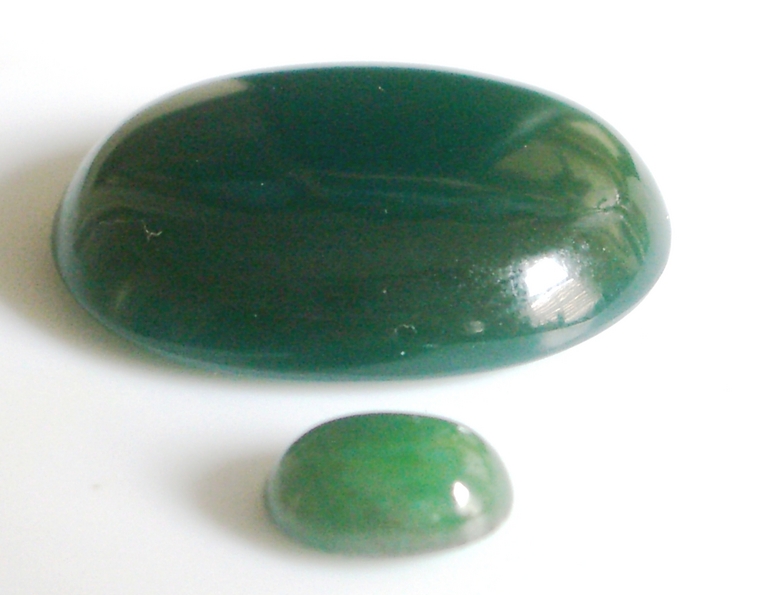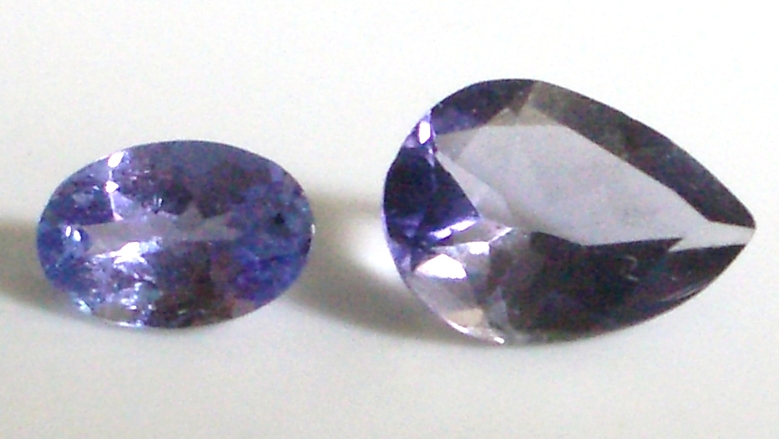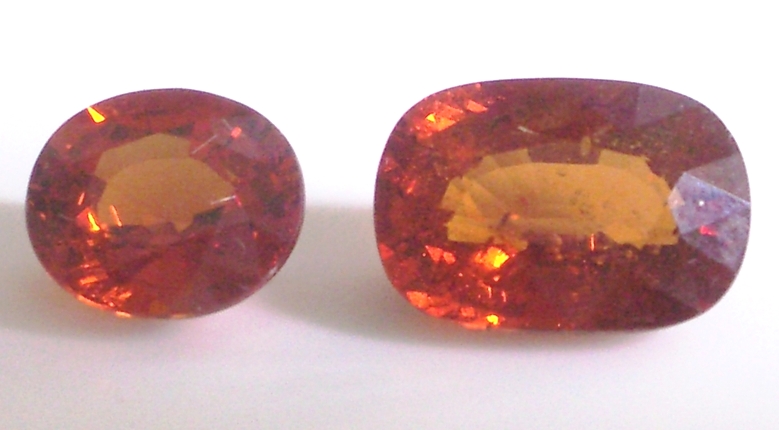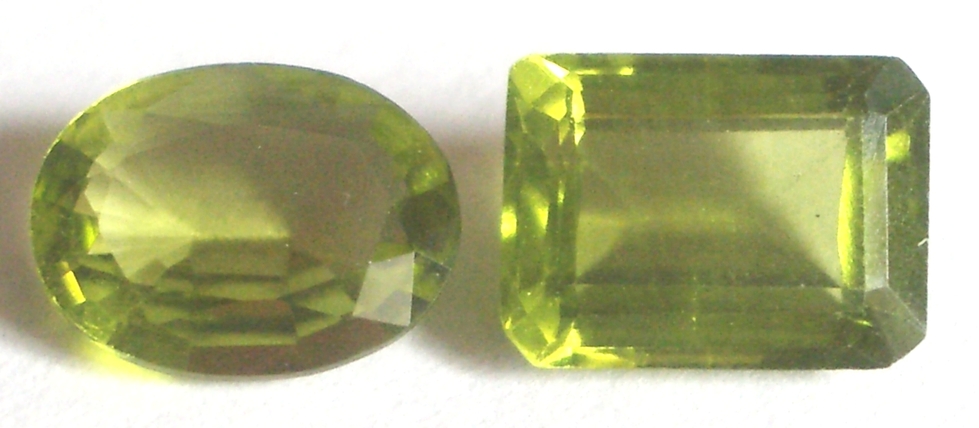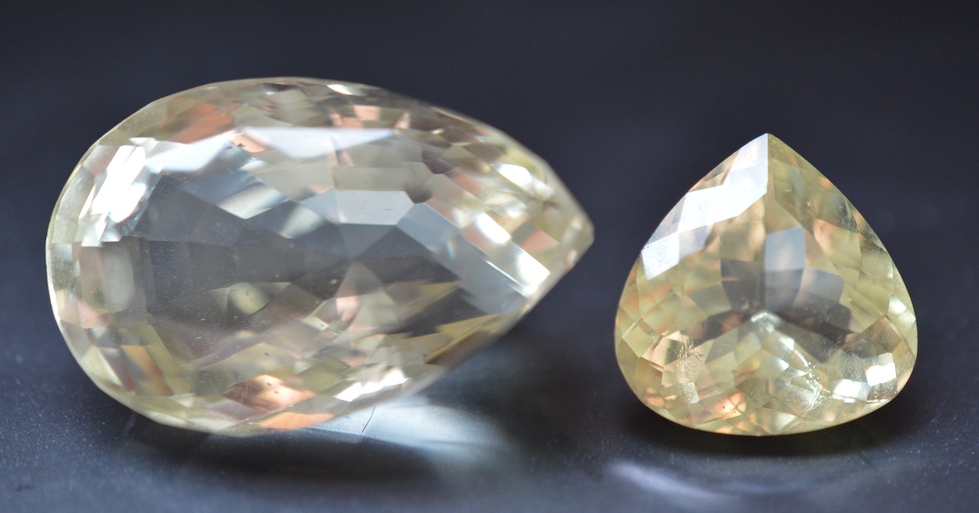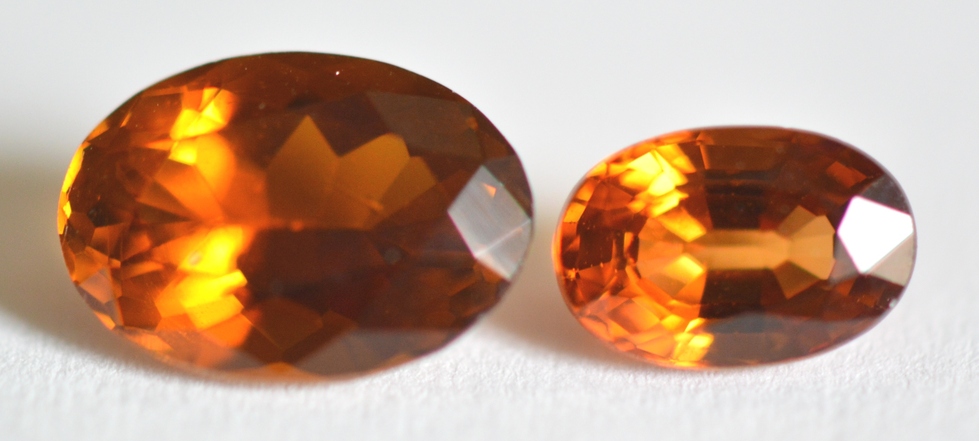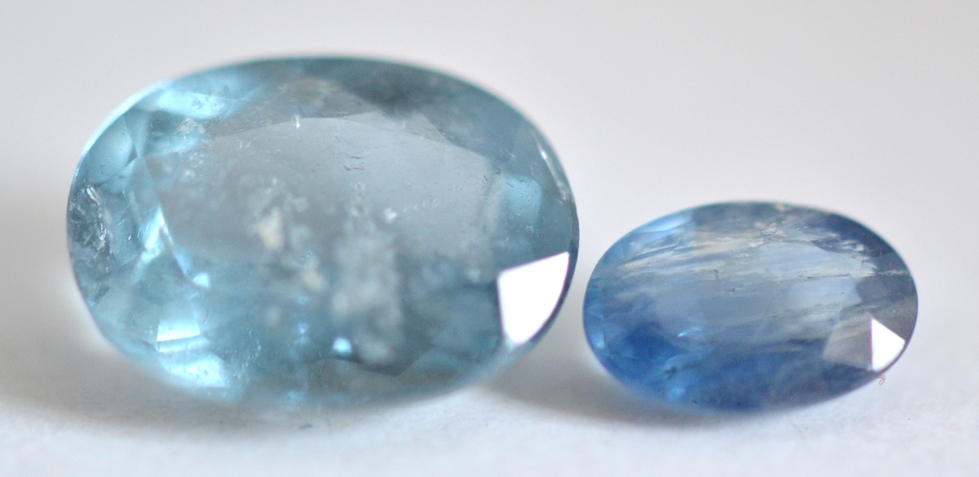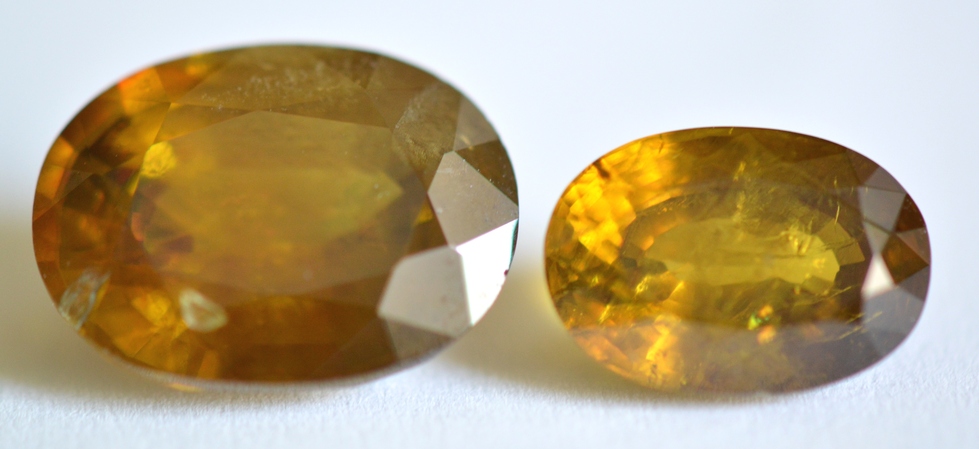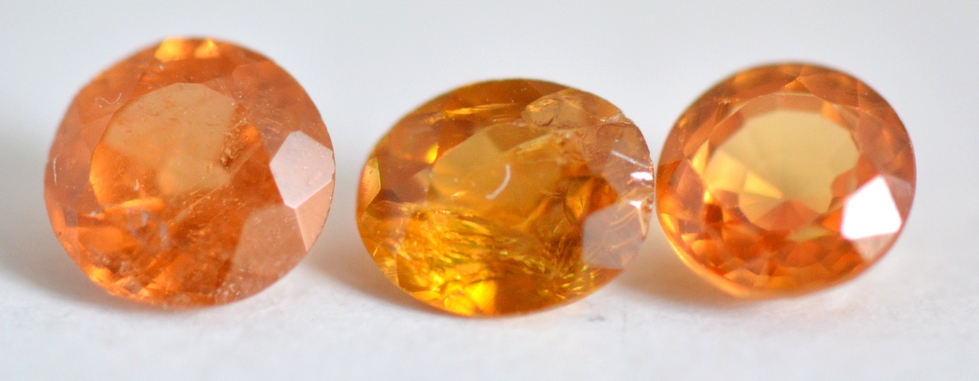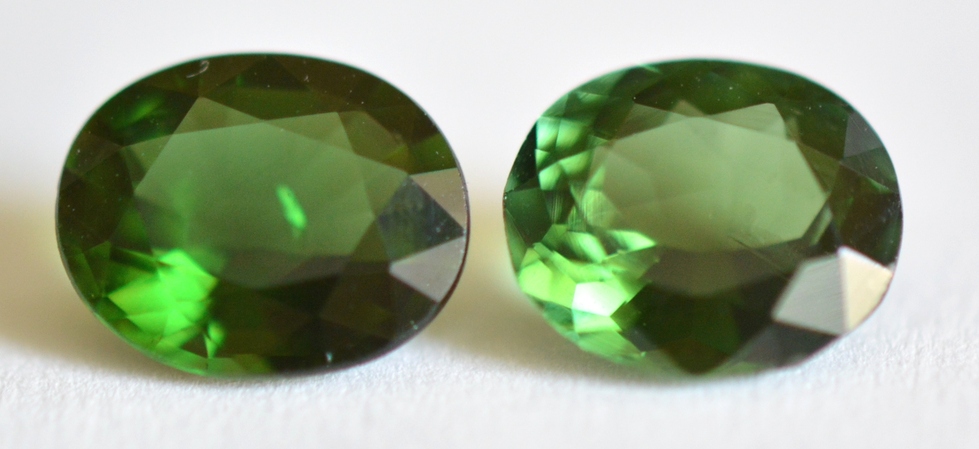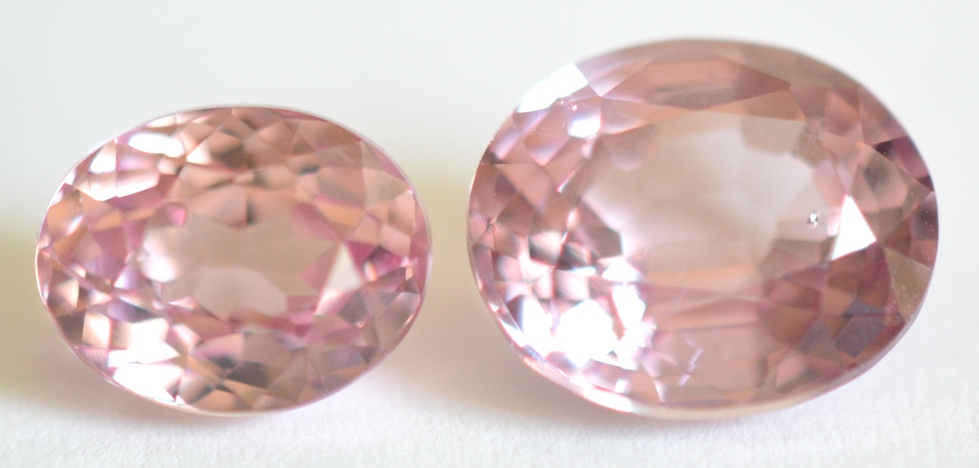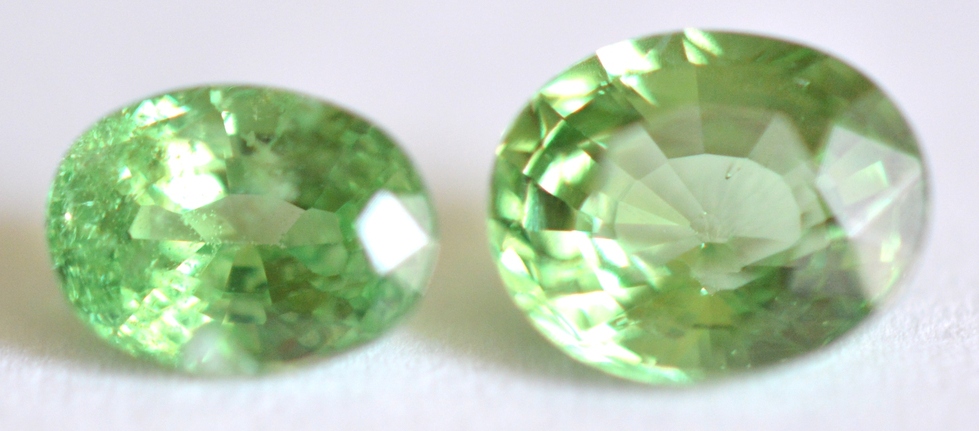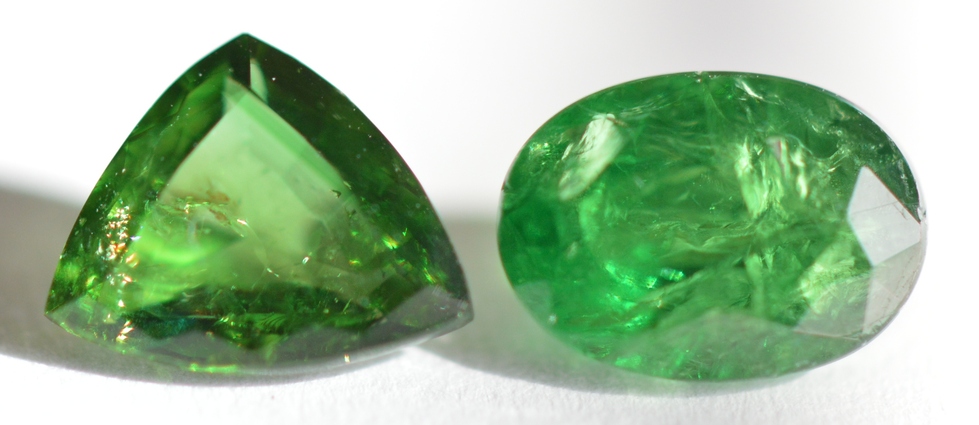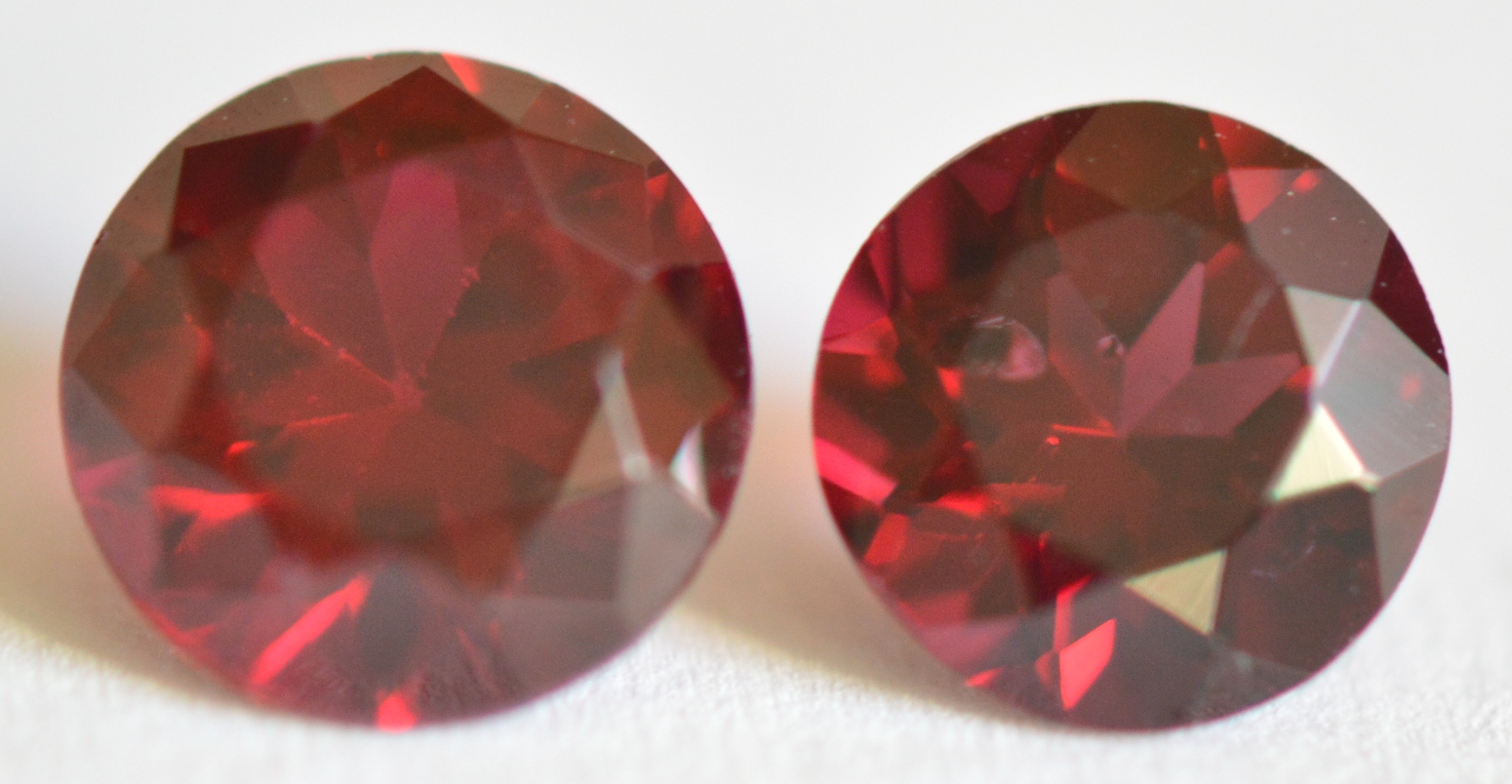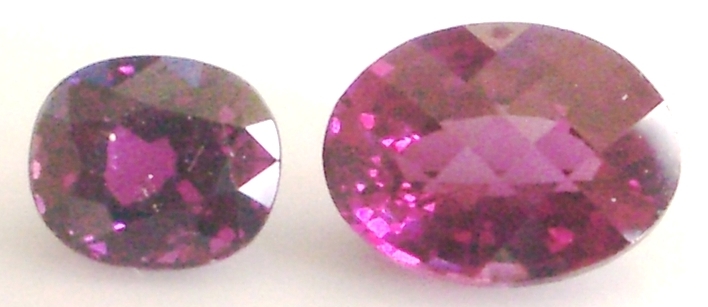Purple Sapphire (Weak) & Rhodolite Garnet (Picks Up)
Aquamarine (Moderate) & Blue Topaz (Inert)
Tanzanite (Inert) & Iolite (Strong)
Dyed Chalcedony Quartz (Inert) &
Jadeite (Moderate)
Purple Sapphire (Weak) &
Amethyst (Inert)
Orange Spessartine Garnet (Pick Up) &
Hessonite Garnet (Strong to Drag)
© Kirk Feral 2009-present, All Rights Reserved. These materials may be duplicated for educational purposes only. No part of this website may be duplicated or distributed for profit, for commercial purposes, or for posting to another website, without the expressed written consent of the copyright holder.
Green Jade (green Jadeite and green Nephrite) contains iron and exhibits moderate to strong magnetism. Jade imitations such as green dyed Chalcedony or dyed Calcite or imitations made from green polymers are all inert. However natural green Jade look-alikes such as Serpentine, Hydrogrossular Garnet, Australian Prehnite and some Chrysoprase are also strongly magnetic, and these cannot be distinguished from genuine Jade by magnetic response.
Aquamarine is a variety of Beryl that can look like pale blue Topaz. Conveniently for us, Aquamarine is weakly to moderately magnetic due to iron, and can easily be separated from blue Topaz, which is a diamagnetic gem colored by color centers.
Peridot (Drag) &
Idocrase (Strong)
Chrome Tourmaline and Verdelite Tourmaline can look similar, but Chrome Tourmaline (a Dravite species) is rarer and more valuable. The two are easily separated with a magnet. The deep green color of Chrome Tourmaline is due to small amounts of vanadium and chromium, and it is usually inert (diamagnetic) when floated, or occasionally very weakly magnetic. Dark green Verdelite Tourmaline (Elbaite species) is colored by a high concentration of iron along with iron-to-titanium charge transfer, and it generally shows a Drag response. A Chelsea filter or UV flashlight can also be used to separate these gems. Only Chrome Tourmaline appears red under a Chelsea filter due to chromium.
Tanzanite can be mistaken for Iolite, a gem with similar violet color. However, Iolite is colored by iron, and it is strongly attracted to a N52 magnet when floated. Tanzanite is colored by small amounts of vanadium (V4+), and shows no magnetic attraction.
Chrome Tourmaline (Inert) & Green Tourmaline (Drags)
Purple Sapphire can at times look similar to Rhodolite Garnet. Both have the nearly same refractive index of approximately 1.76. In addition, Rhodolite can show anomalous double refraction under a polariscope, further confusing it with doubly refractive Sapphire (Corundum). But purple Sapphire is inert to weakly magnetic. Rhodolite will be picked up by an N52 magnet. (A similar separation is seen between purple Spinel and Rhodolite Garnet).
More Examples: Below are more examples of look-alike pairs of natural gems that can easily be separated by differences in magnetic response:
Separating Look-alike Gems
As we become familiar with colored stones, we can often make distinctions between species and varieties based on visual appearance, and at times we can shorten the identification process by eliminating all but just 2 or 3 possibilities. At that point, we may be able to make a final identification by only one test such as refractive index or by testing magnetic response and noting the difference. In most cases, the floatation method is needed to make magnetic responses visible. Below are some examples of look-alike gem pairs that can be separated by magnetic response.
Citrine Quartz and transparent yellow Feldspars such as Orthoclase, Labradorite and Bytownite can look very similar. If you can find an optic figure using a conoscope, a "bull's eye" identifies Quartz. Or just use a magnet to separate them. Most Citrine derives its yellow color from color centers involving aluminum, and is therefore magnetically inert (except in very rare cases). Yellow Feldspar gems derive color from iron impurities (Fe3+). Most show weak to moderate magnetic attraction when floated.
Citrine (Inert) & Yellow Orthoclase (Weak)
Orange Dravite Trourmaline (Inert) &
Hessonite Garnet (Strong)
Blue Tourmaline (Drag) &
Blue Sapphire (Inert to Moderate)
Brown Sphene (Strong) &
Brown Mali Garnet (Drag)
Orange Spessartine Garnet (Pick Up) &
Orange Sapphire (Moderate) &
Orange Mexican Fire Opal (Inert)
Separating Look-alike Garnets: Because most species within the Garnet Group show a Pick-up response, a magnetic wand is frequently not adequate to separate one type of Garnet from another. However, there are a few instances for which a magnet can be used to separate Garnets species that look alike. An example is orange Grossular Garnet (Hessonite) and orange Spessartine Garnet, two species that can be indistinguishable with the naked eye. Also, green Grossular Garnets such as Tsavorite and Merelani can look like green Andradite (Demantoid) Garnet.
Differences in refractive index will separate these different Garnet species, but we can separate them faster with a portable magnetic wand. Orange Spessartine Garnets and green Andradite Garnets always show Pick-up responses. Orange Hessonite Garnets and green Grossular Garnets never pick up, and in most cases they must be floated in order for us to detect any magnetic attraction.
Light orange and light green Grossular Garnets also fluoresce pink under a UV flashlight, while light orange Spessartine Garnets and green Andradite Garnets do not fluoresce.
We always carry a magnetic wand and UV flashlight in our pocket when we intend to buy Garnets at a gem show, as sellers frequently misidentify Garnet species and varieties.
On occasion, we can distinguish between 2 different varieties of Garnet within the same species using a magnetic wand. Chrome Pyrope and Standard Pyrope are red Garnets that can look identical in reflected light, but Chrome Pyrope has less iron content and only shows a drag response (unless the gems are tiny, in which case they pick up). Standard Pyrope gems of average size always pick up.
Chrome Pyrope (Drag) &
Standard Pyrope (Pick Up)
Pink Pastel Pyrope (Drag) &
Pink Malaya (Pick Up)
Merelani Grossular Garnet (Strong) &
Demantoid Andradite Garnet (Pick Up)
Orange Sapphire and orange Spessartine Garnet is another example of a look-alike pair involving Corundum and Garnet. The two species can easily be separated with a refractometer or polariscope, but when we are buying a parcel of orange Sapphires, we will probably not have these tools available to verify that no Spessartine Garnets are mixed into the parcel. Fortunately, we can use our portable magnetic wand to check the entire parcel in just a few seconds. Only the Spessartine Garnets pick up. A UV flashlight can also be used to quickly separate a parcel of these gems, as only the orange Sapphires fluoresce under long wave UV light.
Video: Separating Sapphire from Garnet
Summary of How to Use a Magnet
A neodymium magnet is an important supplemental tool for gem identification. It's particularly handy as a quick identifier for Garnet, and as a separator for synthetics and look-alike gems, including Diamonds. To date, magnetism is a largely unknown aspect of gemology. The field is wide open, and awaits further investigation by hobbyists and gemology researchers alike. Anyone can experiment using a magnetic wand on his/her own gems, jewelry and mineral specimens to discover ways that magnetic responses can aid in identification.
Click here to view a comprehensive list of magnetic responses for gemstones: Magnetic Susceptibility Index.
Chrome Tourmaline (Inert to Weak) &
Tsavorite Garnet (Moderate to Strong)
Ruby and Chrome Pyrope is another example of a Corundum and Garnet look-alike pair. Both are dark red and colored by chromium and iron. But Chrome Pyrope Garnet contains much more iron than Ruby, and also more chromium. Most Rubies are only weakly magnetic, while Chrome Pyrope shows a Drag response. UV fluorescence can also be used to quickly separate Ruby from Chrome Pyrope Garnet. Any fluorescence indicates Ruby.
Ruby (Weak) & Chrome Pyrope Garnet (Drags)
Pink Pastel Pyrope is an unusual and beautiful variety of Pyrope that has lower iron and manganese content than the less rare but equally beautiful Pink Malaya Garnet. Gems of these 2 varieties can look exactly alike, but a simple magnetic wand allows us to distinguish between them. Pastel Pyropes of average size show a Drag response, while Malaya Garnets show a Pick-Up response.
For a more complete list of look-alike gems that can be separated with a magnet, including synthetics and imitations, refer to the Separation Chart for Look-alike Gems.
More information about how to separate varieties of Garnet can be found on page 13 of the Garnet section titled Distinguishing Garnet Species and Varieties.
Purple Sapphire and Rhodolite Garnet can also be separated using some other simple tools, such as a spectroscope or a UV flashlight. Only Garnet shows a strong iron spectrum with a spectroscope, and only purple Sapphire fluoresces red under long wave UV light.
In the photo below, the Peridot on the left and the Chrysoberyl on the right are virtually indistinguishable with the naked eye. Gemologists generally describe Peridot as an idiochromatic gem, deriving green color from significant amounts of iron within its chemical structure. Peridot is one of the few gems that shows a characteristic Drag response without the need for floatation. Chrysoberyl is also colored green primarily by iron, but as an allochromatic gem species, it contains a much lower concentration of iron. Chrysoberyl must be floated in order to see a magnetic response, which ranges from weak to moderate.
Peridot (Drags) and Chrysoberyl (Weak to Moderate)
Magnetism in Gemstones
An Effective Tool and Method for Gem Identification
© Kirk Feral

